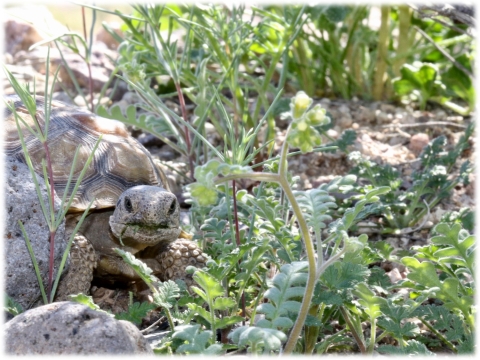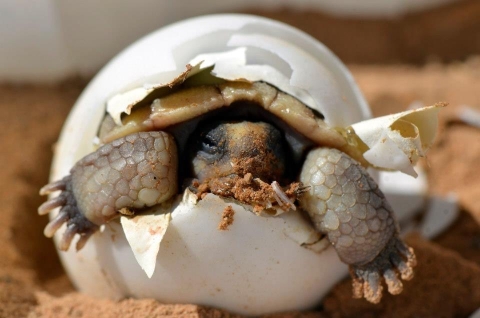The Mojave Desert contains some of the driest and hottest landscapes in North America and represents one the most unique geological and ecological bioregions in the country. However, many factors including utility-scale renewable energy development, urbanization, recreation, and climate change climate change
Climate change includes both global warming driven by human-induced emissions of greenhouse gases and the resulting large-scale shifts in weather patterns. Though there have been previous periods of climatic change, since the mid-20th century humans have had an unprecedented impact on Earth's climate system and caused change on a global scale.
Learn more about climate change are transforming this ecoregion and impacting endemic species such as the federally threatened Mojave desert tortoise.
Mojave desert tortoises are resilient long-lived organisms that have occupied habitats in California, Nevada, Arizona, and Utah for thousands of years. Ancestors of the modern tortoise date back to the late Pleistocene epoch. They use their elephantine limbs to dig burrows to escape temperature extremes – creating habitats and refuges for species such as the sidewinder, black-tailed jackrabbit, kangaroo rat, Gila monster, and many others.
Beyond their burrows, these tortoises have developed a range of adaptations to survive in the arid desert environment, including their ability to store and conserve water and consume limited food by regulating metabolic processes. They forage on a diversity of annual forbs and grasses that generally arrive in the spring and late summer depending on the timing and amount of rainfall. However, recent landscape use changes and habitat degradation have resulted in tortoise food plants being intermixed or replaced by invasive Mediterranean grasses with less nutritional value.
Increased urban expansion and infrastructure development, such as utility-scale solar farms, have also exerted pressures on Mojave Desert ecosystems, resulting in fragmented and degraded habitats in some areas with complex land management and stewardship challenges. Cumulative and persistent climate and landscape-scale changes and threats are contributing to the decline of the Mojave desert tortoise throughout much of its range.
Climate change is having profound impacts on ecosystems and species across the planet, driven by rising global temperatures, changing precipitation patterns, and increasing frequency of extreme weather events. These changes are leading to shifts in species distributions, disruptions to breeding and feeding behaviors, and potential changes in reproductive outputs.
For desert tortoises, changing climates are particularly concerning as the sex of their offspring is dependent on the temperature in which the eggs are incubated. Additionally, prolonged drought can cause localized tortoise mortality events and changes in pollination synchronies for many important plant communities. It can also disrupt predator-prey dynamics, making tortoises the target of many subsidized predators, or predators whose populations have increased because of human food and water subsidies across the desert.
Can tortoises adapt behaviorally and adjust to rapidly changing climates?
Much like tortoises, efforts to protect and recover this species have been slow and steady for more than 30 years. In 1990, most Mojave desert tortoises were protected as threatened under the Endangered Species Act with additional state protections. Recovery efforts for tortoises have been extensive and multifaceted, aiming to address the numerous threats that are contributing to decline while increasing habitat preservation and restoration.
Recovery of the species has been challenged by an incomplete understanding of the threats most responsible for its decline, insufficient information on the effectiveness of management actions as well as the vast geographic and jurisdictional management involved. In recent years, recovery programs such as head-starting and strategically adding tortoises to populations, reducing the numbers of subsidized predators, and installing desert tortoise fencing along roadsides have been initiated simultaneously to bolster wild populations. Effective recovery efforts for Mojave desert tortoises will likely require finding creative solutions to both climate and landscape change as well as prioritizing the conservation of a functioning desert ecosystem, which will also benefit other protected or sensitive species within the region.
Kristina Drakeand Corey Mitchell, Desert Tortoise Recovery Office, Ecological Services, Pacific Southwest Region





